These websites were created to showcase diaries or collections of letters that I personally transcribed and chose to post separately from my Spared & Shared Websites—not because they were necessarily superior in terms of content, but because there were multiple letters penned by the same author or because they were “commissioned” by a contributor who preferred to have them stand alone. A synopsis of each website is presented below in no particular order with a link for your convenience. At last count, there were 62 of them. As I add more, I will add them to the top of this page so be sure to check back later. A comprehensive list of all the Civil War soldier letters I have transcribed can be found at Billy Yank & Johnny Reb Letters. — Griff (January 2018)
“The Civil War Letters of Benjamin Curtis Lincoln while serving in the 39th Massachusetts Volunteers”
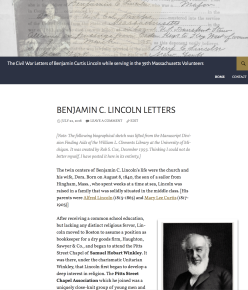 As many as four Lincolns simultaneously serving in the Civil War. Ben’s eldest brother, Alfred A. Lincoln (b. ca.1838), served with the 4th Mass.—a three months’ regiment, and later with Co. E of the 32nd Mass. Another brother, Samuel M. Lincoln was in Co. H of the 23rd Mass., while a brother-in-law, George Miller, died in the service in 1863. It was natural, then, with his personal and family commitments, that Ben Curtis Lincoln would enlist, and in August, 1862, he and his close friends from the Pitts Street Chapel Association, Charlie H. C. Brown and Samuel G. Hall, enlisted as privates in Co. G, 39th Mass. Infantry. Link
As many as four Lincolns simultaneously serving in the Civil War. Ben’s eldest brother, Alfred A. Lincoln (b. ca.1838), served with the 4th Mass.—a three months’ regiment, and later with Co. E of the 32nd Mass. Another brother, Samuel M. Lincoln was in Co. H of the 23rd Mass., while a brother-in-law, George Miller, died in the service in 1863. It was natural, then, with his personal and family commitments, that Ben Curtis Lincoln would enlist, and in August, 1862, he and his close friends from the Pitts Street Chapel Association, Charlie H. C. Brown and Samuel G. Hall, enlisted as privates in Co. G, 39th Mass. Infantry. Link
“Though Distant Lands Between Us Be”
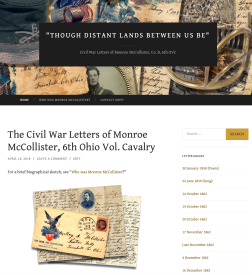 An archive of civil war letters by Monroe McCollister who served in Co. B, 6th Ohio Volunteer Cavalry (OVC). Monroe did not enlist until late in 1862 and was not transported east to join the regiment until February 1863. The following month—before he was even assigned a horse—he contracted the black measles and died at Potomac Station in Virginia, leaving a wife and two children. Many of the letters originate at Camp Cleveland in Ohio; several are by other soldiers in the 6th OVC as they communicate with Monroe’s widow with respect to his burial location, his money, and his personal effects. Link
An archive of civil war letters by Monroe McCollister who served in Co. B, 6th Ohio Volunteer Cavalry (OVC). Monroe did not enlist until late in 1862 and was not transported east to join the regiment until February 1863. The following month—before he was even assigned a horse—he contracted the black measles and died at Potomac Station in Virginia, leaving a wife and two children. Many of the letters originate at Camp Cleveland in Ohio; several are by other soldiers in the 6th OVC as they communicate with Monroe’s widow with respect to his burial location, his money, and his personal effects. Link
“Tell Her to Keep Good Heart”
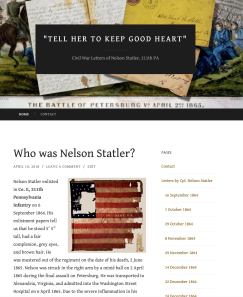 An archive of late war letters by Cpl. Nelson Statler who enlisted (or was dafted) into Co. E, 211th Pennsylvania Infantry. He served from early September 1864 until 2 June 1865 when he died from complications associated with the amputation of his right arm which was struck by a minié ball during the final assault of the rebel defenses at Petersburg on 2 April 1865. The battle was Nelson’s second battle; his first being the Battle at Fort Stedman a week earlier. The last six letters in the archive were written by two chaplains and a nurse as Statler was incapable of writing himself. There are also letters to Nelson from three siblings. Link
An archive of late war letters by Cpl. Nelson Statler who enlisted (or was dafted) into Co. E, 211th Pennsylvania Infantry. He served from early September 1864 until 2 June 1865 when he died from complications associated with the amputation of his right arm which was struck by a minié ball during the final assault of the rebel defenses at Petersburg on 2 April 1865. The battle was Nelson’s second battle; his first being the Battle at Fort Stedman a week earlier. The last six letters in the archive were written by two chaplains and a nurse as Statler was incapable of writing himself. There are also letters to Nelson from three siblings. Link
“May Heaven Protect You”
 Wearing a sombre expression and a slightly oversized greatcoat, 14-year-old Lucian Wells Hubbard posed in a studio in Hartford, Conn., in front of a photographer’s army camp backdrop of Sibley tents and cannon balls. After his keepsake image was taken, shortly after his enlistment in July 1862, the drummer in the 14th Connecticut began a momentous, 21-month journey. This is the story, told by his letters, of a very young drummer boy who served his country and died at Andersonville. Link
Wearing a sombre expression and a slightly oversized greatcoat, 14-year-old Lucian Wells Hubbard posed in a studio in Hartford, Conn., in front of a photographer’s army camp backdrop of Sibley tents and cannon balls. After his keepsake image was taken, shortly after his enlistment in July 1862, the drummer in the 14th Connecticut began a momentous, 21-month journey. This is the story, told by his letters, of a very young drummer boy who served his country and died at Andersonville. Link
Moreau Forrest–Lt. Commander in the US Navy during the Civil War
 A collection of letters written by Moreau Forrest (1841-1866); US Navy from 1858 until 1866. He left Annapolis in 1861 to join the Atlantic blockade and later was appointed Lt. Commander of the 11th Dist. in Admiral Lee’s Brown-water navy headquartered at Chattanooga. Forrest served on the “Colorado,” the “Keokuk,” the “Lehigh,” and the “Florida.” Included with the archive are letters by his half-brother, and other prominent individuals in the Navy and private life. Link
A collection of letters written by Moreau Forrest (1841-1866); US Navy from 1858 until 1866. He left Annapolis in 1861 to join the Atlantic blockade and later was appointed Lt. Commander of the 11th Dist. in Admiral Lee’s Brown-water navy headquartered at Chattanooga. Forrest served on the “Colorado,” the “Keokuk,” the “Lehigh,” and the “Florida.” Included with the archive are letters by his half-brother, and other prominent individuals in the Navy and private life. Link
The Civil War Letters of James Henry Clark, Co. A ~ 3rd Vermont Vols
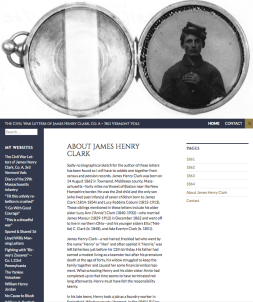 A collection of Civil War letters written by James Henry Clark during his three years of service with Co. A, 3rd Vermont Infantry. “Henry” was born in Townsend, Massachusetts, but enlisted with his friends from Springfield, Vermont, not long after the firing on Fort Sumter. Henry was killed in action serving as the color guard of his regiment during the Battle of the Wilderness in May 1864—just weeks before his enlistment expired. Most of the letters were written by Henry; the last two were written by his comrade, Edward D. Hatch, who hastily buried Henry’s body on the battlefield. Link
A collection of Civil War letters written by James Henry Clark during his three years of service with Co. A, 3rd Vermont Infantry. “Henry” was born in Townsend, Massachusetts, but enlisted with his friends from Springfield, Vermont, not long after the firing on Fort Sumter. Henry was killed in action serving as the color guard of his regiment during the Battle of the Wilderness in May 1864—just weeks before his enlistment expired. Most of the letters were written by Henry; the last two were written by his comrade, Edward D. Hatch, who hastily buried Henry’s body on the battlefield. Link
Diary of the 29th Mass. Infantry
 The 41-page diary by a soldier in Co. G, 29th Mass. Vols. It spans the period from May 10th to July 8th (1862) as the regiment participated in the Peninsula Campaign while attached to the Irish Brigade under the command of Brig. Gen. Thomas Meagher. Includes descriptions of the fighting near Fair Oaks, Savage’s Station, White Oak Swamp, Glendale, and Malvern Hill. The diary appears to have been written in segments and mailed home. Link
The 41-page diary by a soldier in Co. G, 29th Mass. Vols. It spans the period from May 10th to July 8th (1862) as the regiment participated in the Peninsula Campaign while attached to the Irish Brigade under the command of Brig. Gen. Thomas Meagher. Includes descriptions of the fighting near Fair Oaks, Savage’s Station, White Oak Swamp, Glendale, and Malvern Hill. The diary appears to have been written in segments and mailed home. Link
“Till This Unholy Rebellion is Crushed”
 Sixty letters by Dory and Morty Longwood of Co. C, 7th Indiana Infantry. These letters span the period of time from 1862 to 1865, chronicling the experience of Dory as he joins other recruits in the fall of 1862, while he works as a nurse at the Fairfield Seminary Hospital, and after he finally joins his older brother in the regiment just before the Battle of Chancellorsville. Dory was captured in the fighting at Weldon Railroad in August 1864 and served out the rest of the war a prisoner. Nearly all of the letters were written to their parents in Aberdeen, Ohio county, IN. LINK
Sixty letters by Dory and Morty Longwood of Co. C, 7th Indiana Infantry. These letters span the period of time from 1862 to 1865, chronicling the experience of Dory as he joins other recruits in the fall of 1862, while he works as a nurse at the Fairfield Seminary Hospital, and after he finally joins his older brother in the regiment just before the Battle of Chancellorsville. Dory was captured in the fighting at Weldon Railroad in August 1864 and served out the rest of the war a prisoner. Nearly all of the letters were written to their parents in Aberdeen, Ohio county, IN. LINK
“I Go With Good Courage”
 Sixty-four letters by 3rd Class Musician Henry C. Long of the 11th Maine. Though he had a limited education, Long’s letters to his wife provide phenomenal detail on the regiment while in Washington and on their march with McClellan’s Army of the Potomac up to and including their first engagement at Fair Oaks. Henry wrote faithfully twice a week during most of this period. Much is said of the effort by Congress to pass a bill discharging the regimental bands from the service which was not accomplished until after the Peninsula Campaign. Unfortunately, Henry died of typhoid fever before the bill was passed. LINK
Sixty-four letters by 3rd Class Musician Henry C. Long of the 11th Maine. Though he had a limited education, Long’s letters to his wife provide phenomenal detail on the regiment while in Washington and on their march with McClellan’s Army of the Potomac up to and including their first engagement at Fair Oaks. Henry wrote faithfully twice a week during most of this period. Much is said of the effort by Congress to pass a bill discharging the regimental bands from the service which was not accomplished until after the Peninsula Campaign. Unfortunately, Henry died of typhoid fever before the bill was passed. LINK
“Tough as a Pitch Pine Knot”
 Forty letters written by Sgt. John Whitcomb Piper (1820-1903) of Co. L, 4th Massachusetts Heavy Artillery is a delightful read and offers a sustained view of Washington D. C. from the perspective of a non-commissioned officer not commonly found during the civil war. Serving as the company’s commissary sergeant, Piper was permitted to cross the Potomac in and out of Washington on nearly a daily basis seeking provisions and running various sundry errands for “his boys” in Company L. He used the opportunity to visit places of interest in the city and wrote home regularly and faithfully to his wife in Lynn, Massachusetts, of his daily “tramp.” LINK
Forty letters written by Sgt. John Whitcomb Piper (1820-1903) of Co. L, 4th Massachusetts Heavy Artillery is a delightful read and offers a sustained view of Washington D. C. from the perspective of a non-commissioned officer not commonly found during the civil war. Serving as the company’s commissary sergeant, Piper was permitted to cross the Potomac in and out of Washington on nearly a daily basis seeking provisions and running various sundry errands for “his boys” in Company L. He used the opportunity to visit places of interest in the city and wrote home regularly and faithfully to his wife in Lynn, Massachusetts, of his daily “tramp.” LINK
The Ralph Leland Goodrich Diaries
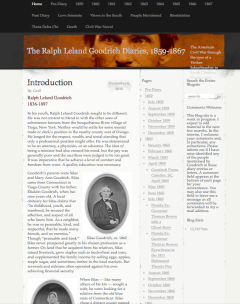 The diaries and letters of Ralph Leland Goodrich, a northerner by birth, who was employed as a school teacher prior to the Civil War in Camden SC, Tallahassee FL, and finally Little Rock AK, where he found himself at the time the state seceded from the Union. In spite of having a brother in the Union army, Ralph enlisted in the Capitol Guards (Co. A, 6th AK) though he quickly realized he did not have the physical constitution nor the doughtiness to withstand the rigors of camp life—especially to risk his life for a cause he did heartily embrace. Ralph’s twelve previously unpublished diaries are housed at the Arkansas History Commission in Little Rock. LINK
The diaries and letters of Ralph Leland Goodrich, a northerner by birth, who was employed as a school teacher prior to the Civil War in Camden SC, Tallahassee FL, and finally Little Rock AK, where he found himself at the time the state seceded from the Union. In spite of having a brother in the Union army, Ralph enlisted in the Capitol Guards (Co. A, 6th AK) though he quickly realized he did not have the physical constitution nor the doughtiness to withstand the rigors of camp life—especially to risk his life for a cause he did heartily embrace. Ralph’s twelve previously unpublished diaries are housed at the Arkansas History Commission in Little Rock. LINK
“This is a Dreadful War”
 A small collection of letters exchanged between Jacob Bauer and his wife Emily. The correspondence gives us a glimpse into the world of a German immigrant who served in Co. G, 16th Connecticut. At the Battle of Antietam—the regiment’s first fight— Bauer survived physically unscathed, but the regiment was routed in a cornfield outside the village of Sharpsburg, Md., on Sept. 17, 1862, suffering 43 killed and 161 wounded. Bauer was later captured at Plymouth, N. C., with most of his regiment and sent to Andersonville where he somehow survived and was paroled on Dec. 10, 1864. This website was a collaboration with John Banks who purchased the letters and sought to share them. LINK
A small collection of letters exchanged between Jacob Bauer and his wife Emily. The correspondence gives us a glimpse into the world of a German immigrant who served in Co. G, 16th Connecticut. At the Battle of Antietam—the regiment’s first fight— Bauer survived physically unscathed, but the regiment was routed in a cornfield outside the village of Sharpsburg, Md., on Sept. 17, 1862, suffering 43 killed and 161 wounded. Bauer was later captured at Plymouth, N. C., with most of his regiment and sent to Andersonville where he somehow survived and was paroled on Dec. 10, 1864. This website was a collaboration with John Banks who purchased the letters and sought to share them. LINK
“My Own Dear Lot”
 Fifty letters written by Sarah Cornelia (“Neal”) Alden (1841-1888) to Capt. Lot Abraham while he served in Co. D, 4th Iowa Cavalry during the war. Neil’s strong faith gave her courage to overcome life’s obstacles and her patriotism in the darkest hours of the national calamity that pitted brother against brother on the battlefield—and neighbor against neighbor on the home front—was nothing short of incredible. Her constant voice of encouragement and expressions of hope written to Lot during the nearly four years of separation must have been an incalculable inspiration to him. Transcripts of their diaries, now archived at the Univ. of Iowa, are included. LINK
Fifty letters written by Sarah Cornelia (“Neal”) Alden (1841-1888) to Capt. Lot Abraham while he served in Co. D, 4th Iowa Cavalry during the war. Neil’s strong faith gave her courage to overcome life’s obstacles and her patriotism in the darkest hours of the national calamity that pitted brother against brother on the battlefield—and neighbor against neighbor on the home front—was nothing short of incredible. Her constant voice of encouragement and expressions of hope written to Lot during the nearly four years of separation must have been an incalculable inspiration to him. Transcripts of their diaries, now archived at the Univ. of Iowa, are included. LINK
“My Eyes Saw All—in Red & Flame”
 The letters of Adj. William Beynon Phillips, a native of Wales. Like thousands of emigrants who felt a sense of duty to support the government of the nation in which they chose to live, William enlisted in what became Battery M, 2nd Penn. Heavy Artillery. The letters are an insider’s view of the aforementioned regiment from 1862 to 1864 and the “Provisional Heavies” that were detached in 1864. Sprinkled among the letters are a few written by William Davis who served in the same unit. The letters end 10 days prior to the Battle of the Crater where William was taken prisoner. LINK
The letters of Adj. William Beynon Phillips, a native of Wales. Like thousands of emigrants who felt a sense of duty to support the government of the nation in which they chose to live, William enlisted in what became Battery M, 2nd Penn. Heavy Artillery. The letters are an insider’s view of the aforementioned regiment from 1862 to 1864 and the “Provisional Heavies” that were detached in 1864. Sprinkled among the letters are a few written by William Davis who served in the same unit. The letters end 10 days prior to the Battle of the Crater where William was taken prisoner. LINK
Staten Island Soldiers
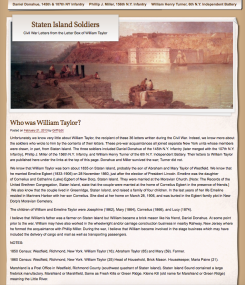 Unfortunately we know very little about William Taylor, the recipient of these 36 letters written during the Civil War. Indeed, we know more about the soldiers who wrote to him by the contents of their letters. These pre-war acquaintances all joined separate New York units whose members were drawn, in part, from Staten Island. The three soldiers included Daniel Donahue, 145th N.Y. Infantry (later merged with the 107th N.Y. Infantry), Phillip J. Miller, 156th N.Y. Infantry, and William Henry Turner, 6th N.Y. Independent Battery. Donahue and Miller survived the war; Turner did not. LINK
Unfortunately we know very little about William Taylor, the recipient of these 36 letters written during the Civil War. Indeed, we know more about the soldiers who wrote to him by the contents of their letters. These pre-war acquaintances all joined separate New York units whose members were drawn, in part, from Staten Island. The three soldiers included Daniel Donahue, 145th N.Y. Infantry (later merged with the 107th N.Y. Infantry), Phillip J. Miller, 156th N.Y. Infantry, and William Henry Turner, 6th N.Y. Independent Battery. Donahue and Miller survived the war; Turner did not. LINK
When Duty Calls—The McClure Family Civil War Letters & Diaries
 The transcripts of these diaries & letters of the McClure family were offered to me for publication after I shared with them a letter/image by/of Sgt. Samuel McClure, 31st Wis., that fell into the hands of my g-g-grandmother’s brother, Capt. James H. Green, 8th Wisc (see story). The transcripts are a incredible story of a father—already in his 50’s—and his only two sons volunteering to serve with Wisc. regiments. Tragically, Samuel and Maria McClure lost both their sons in what Samuel termed as “atonement” for the great “National Sin.” I was honored for the opportunity to publish them. LINK
The transcripts of these diaries & letters of the McClure family were offered to me for publication after I shared with them a letter/image by/of Sgt. Samuel McClure, 31st Wis., that fell into the hands of my g-g-grandmother’s brother, Capt. James H. Green, 8th Wisc (see story). The transcripts are a incredible story of a father—already in his 50’s—and his only two sons volunteering to serve with Wisc. regiments. Tragically, Samuel and Maria McClure lost both their sons in what Samuel termed as “atonement” for the great “National Sin.” I was honored for the opportunity to publish them. LINK
“From Your Affectionate Son”
 A native of England but raised in Pontiac, Michigan, Charles J. Fox joined the reorganized 4th Michigan Infantry in 1864. Fox was lieutenant in his company and later captain in Co. H, under Col. Jairus W. Hall, and saw service in Tennessee, Alabama, Mississippi, and Texas. He served on the general staff at San Antonio, Texas, and had charge of cleaning up the city. In those days, San Antonio had but fifteen thousand population. He was mustered out at Houston, Texas, May 26, 1866. A dutiful son, Fox wrote more than 80 letters to his parents during his service. LINK
A native of England but raised in Pontiac, Michigan, Charles J. Fox joined the reorganized 4th Michigan Infantry in 1864. Fox was lieutenant in his company and later captain in Co. H, under Col. Jairus W. Hall, and saw service in Tennessee, Alabama, Mississippi, and Texas. He served on the general staff at San Antonio, Texas, and had charge of cleaning up the city. In those days, San Antonio had but fifteen thousand population. He was mustered out at Houston, Texas, May 26, 1866. A dutiful son, Fox wrote more than 80 letters to his parents during his service. LINK
Crossing Hell on a Wooden Bridge
 This website was created to showcase the large collection of George Wilkinson who has devoted over 25 years to the preservation of materials connected with the 4th Michigan. In his intro, George writes, “As you visit the various pages of this site, you will discover an extensive collection of images, letters, documents, diaries, etc., all of which I hope you find just as interesting and rewarding as they have been for me. Study the photos of these men and read the thoughts that they put to paper and you’ll have a momentary glimpse of the war-torn world in which they fought so hard to survive…” LINK
This website was created to showcase the large collection of George Wilkinson who has devoted over 25 years to the preservation of materials connected with the 4th Michigan. In his intro, George writes, “As you visit the various pages of this site, you will discover an extensive collection of images, letters, documents, diaries, etc., all of which I hope you find just as interesting and rewarding as they have been for me. Study the photos of these men and read the thoughts that they put to paper and you’ll have a momentary glimpse of the war-torn world in which they fought so hard to survive…” LINK
“All glory to our flag—and to those who defend it!”
 Several captivating letters by Capt. Augustus A. Gibson, a veteran of the War with Mexico and the Third Seminole Indian War, who was the commander of Ft. Delaware when the Civil War began. His skill as an artillerist was legendary. One soldier said of him: “He is the best shot in the artillery, except Gen. Bragg, CSA. He used to set a dry goods box in the bay at Ft. Delaware and set it on fire with a shell. A good shot that!” Itching for field duty, Gibson accepted the colonelship of the 2d Penn. Heavy Artillery only to be sent to Ft. Lincoln in Washington DC. He later resigned his commission with the “Heavies” to return to the regular army, his resignation prompted by a long-standing bitter dispute between himself and Gov. Curtin of Pennsylvania over the appointments of officers in the regiment. LINK
Several captivating letters by Capt. Augustus A. Gibson, a veteran of the War with Mexico and the Third Seminole Indian War, who was the commander of Ft. Delaware when the Civil War began. His skill as an artillerist was legendary. One soldier said of him: “He is the best shot in the artillery, except Gen. Bragg, CSA. He used to set a dry goods box in the bay at Ft. Delaware and set it on fire with a shell. A good shot that!” Itching for field duty, Gibson accepted the colonelship of the 2d Penn. Heavy Artillery only to be sent to Ft. Lincoln in Washington DC. He later resigned his commission with the “Heavies” to return to the regular army, his resignation prompted by a long-standing bitter dispute between himself and Gov. Curtin of Pennsylvania over the appointments of officers in the regiment. LINK
The Cary Family Letters
 The letters of John Baytop Cary, who conducted a private school from 1851 until the Civil War in Hampton, Va., not far from Ft. Monroe. When Virginia seceded, Cary’s older boy students quit school to volunteer. Cary himself was commissioned a Confederate officer, serving under Gen. John B. Magruder to defend the Peninsula against Gen. McClellan’s 1862 invasion. He is best known for confronting Gen. Benjamin Butler—under a flag of truce—at Ft. Monroe to object to the taking of slaves as “contraband of war.” He was mustered out of service after Appomattox and proudly remained “Colonel Cary” for the rest of his life. These letters were made available for me to publish by Margaret D. Ryther. LINK
The letters of John Baytop Cary, who conducted a private school from 1851 until the Civil War in Hampton, Va., not far from Ft. Monroe. When Virginia seceded, Cary’s older boy students quit school to volunteer. Cary himself was commissioned a Confederate officer, serving under Gen. John B. Magruder to defend the Peninsula against Gen. McClellan’s 1862 invasion. He is best known for confronting Gen. Benjamin Butler—under a flag of truce—at Ft. Monroe to object to the taking of slaves as “contraband of war.” He was mustered out of service after Appomattox and proudly remained “Colonel Cary” for the rest of his life. These letters were made available for me to publish by Margaret D. Ryther. LINK
In the Trough of the Sea
 These letters were written by Acting Assistant Surgeon Allen Smith Heath (1821-1910), from aboard the USS Daylight after the steamer was commissioned (7 June 1861) and sent up the James River in Virginia. The Daylight was attached to the North Atlantic Blockading Squadron and was the flagship engaged in the reduction of Fort Macon, N.C. Following his service on the USS Daylight, Dr. Heath enlisted as the surgeon of the 170th New York Infantry (Corcoran’s Irish Legion). He was chief surgeon on the staffs of Gen. King in West Virginia and of Gen. Corcoran in Ga. He was wounded so seriously in the latter campaign that it handicapped him in his profession for the remainder of his life. LINK
These letters were written by Acting Assistant Surgeon Allen Smith Heath (1821-1910), from aboard the USS Daylight after the steamer was commissioned (7 June 1861) and sent up the James River in Virginia. The Daylight was attached to the North Atlantic Blockading Squadron and was the flagship engaged in the reduction of Fort Macon, N.C. Following his service on the USS Daylight, Dr. Heath enlisted as the surgeon of the 170th New York Infantry (Corcoran’s Irish Legion). He was chief surgeon on the staffs of Gen. King in West Virginia and of Gen. Corcoran in Ga. He was wounded so seriously in the latter campaign that it handicapped him in his profession for the remainder of his life. LINK
Lloyd Willis Manning Letters
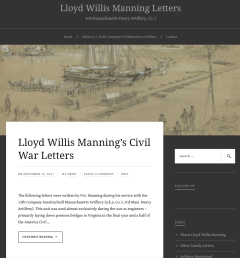 A collection of 37 letters by Lloyd Willis Manning, a machinist in the Springfield Armory. He was married to Lydia F. Phillips in January 1864—just days before enlisting in Co. I, 3rd Massachusetts Heavy Artillery. This unit was used almost exclusively as engineers—primarily laying down pontoon bridges in the final year and a half of the war. Lloyd was offered the “choice” position as cook for the officers, enabling him to avoid less desirable duties, to eat well, and stay out of the line of fire. It also gave him time to record his observations of the war from the vicinity of Bermuda Hundred where he spent the majority of his time. LINK
A collection of 37 letters by Lloyd Willis Manning, a machinist in the Springfield Armory. He was married to Lydia F. Phillips in January 1864—just days before enlisting in Co. I, 3rd Massachusetts Heavy Artillery. This unit was used almost exclusively as engineers—primarily laying down pontoon bridges in the final year and a half of the war. Lloyd was offered the “choice” position as cook for the officers, enabling him to avoid less desirable duties, to eat well, and stay out of the line of fire. It also gave him time to record his observations of the war from the vicinity of Bermuda Hundred where he spent the majority of his time. LINK
The Yankee Volunteer
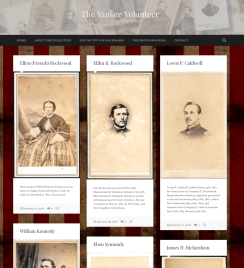 Showcases the incredible collection of carte-de-visits (CDVs) collected by Dave Morin, a life-long resident of the Old Granite State—New Hampshire. Dave’s collection is includes 250+ military images representing most of the branches. Though his preference has been to collect CDVs of New Hampshire soldiers, he has a sprinkling of soldiers and notable civilian images from most of the New England States. Believing it important to share his collection with others, Dave chose this format to display them. His goal is simple—to bring as many of the NH boys as he can back to the Old Granite State. LINK
Showcases the incredible collection of carte-de-visits (CDVs) collected by Dave Morin, a life-long resident of the Old Granite State—New Hampshire. Dave’s collection is includes 250+ military images representing most of the branches. Though his preference has been to collect CDVs of New Hampshire soldiers, he has a sprinkling of soldiers and notable civilian images from most of the New England States. Believing it important to share his collection with others, Dave chose this format to display them. His goal is simple—to bring as many of the NH boys as he can back to the Old Granite State. LINK
“I thought my bacon was smoked”
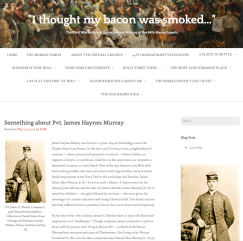 Forty-five letters by James Haynes Murray of Somerville, Mass. James enlisted in August 1862 in Co. C, 44th Massachusetts. The letters follow James 9 months of service, mostly in North Carolina. After a skirmish at Rawl’s Mills, the 44th was thrown into the fray at the Battle of White Hall. Here in the twilight of a cold winter’s evening, firing from behind a rail fence at an unseen enemy hidden in the trees across the Neuse river, James hugged the cold, hard ground as the enemy’s “bullets came whistling across rather too fast for comfort.” Link
Forty-five letters by James Haynes Murray of Somerville, Mass. James enlisted in August 1862 in Co. C, 44th Massachusetts. The letters follow James 9 months of service, mostly in North Carolina. After a skirmish at Rawl’s Mills, the 44th was thrown into the fray at the Battle of White Hall. Here in the twilight of a cold winter’s evening, firing from behind a rail fence at an unseen enemy hidden in the trees across the Neuse river, James hugged the cold, hard ground as the enemy’s “bullets came whistling across rather too fast for comfort.” Link
“When I Come Home…”
 40+ letters by George Morgan, of Sutton, NH, who enlisted in Co. F, 11th New Hampshire in August 1862. George’s letters do not suggest he was eager to “save his country” or to risk his life to “put down the rebellion” as were many of the youth who ran off to enlistment offices in the spring of 1861. Neither was he motivated to come to the aid of the Negroes held in bondage in the South whom he clearly despised and spoke of in the most derogatory terms. Rather, he seems to have viewed the war as an opportunity to earn easy money and so waited until late 1862 when bounties were being offered to fill the state quotas. LINK
40+ letters by George Morgan, of Sutton, NH, who enlisted in Co. F, 11th New Hampshire in August 1862. George’s letters do not suggest he was eager to “save his country” or to risk his life to “put down the rebellion” as were many of the youth who ran off to enlistment offices in the spring of 1861. Neither was he motivated to come to the aid of the Negroes held in bondage in the South whom he clearly despised and spoke of in the most derogatory terms. Rather, he seems to have viewed the war as an opportunity to earn easy money and so waited until late 1862 when bounties were being offered to fill the state quotas. LINK
“I am for war, till slavery is dead”
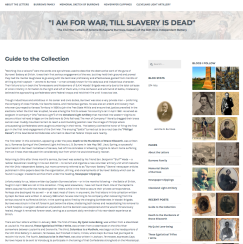 The letters of Jerome B. Burrows—an ardent anti-slavery man who joined the Free State Militia in Kansas Territory to ensure that justice prevailed in the elections. In 1861, Jerome was quick to enlist as a sergeant in Co. F of the Cleveland Light Artillery that moved into Virginia to secure critical bridges on the B&O RR. The men literally dragged their brass cannon over muddy mountain terrain to reach a commanding position near the village of Philippi, surprising slumbering Rebels in their tents and claimed the honor of firing the 1st gun in the 1st land engagement of the war. LINK
The letters of Jerome B. Burrows—an ardent anti-slavery man who joined the Free State Militia in Kansas Territory to ensure that justice prevailed in the elections. In 1861, Jerome was quick to enlist as a sergeant in Co. F of the Cleveland Light Artillery that moved into Virginia to secure critical bridges on the B&O RR. The men literally dragged their brass cannon over muddy mountain terrain to reach a commanding position near the village of Philippi, surprising slumbering Rebels in their tents and claimed the honor of firing the 1st gun in the 1st land engagement of the war. LINK
“Hurrah for the Old Flag”
 Eight letters by Henry (“Hank”) Clay Forbes of Co. B, 26th Iowa Volunteers. Unlike many of the Iowa farm boys volunteering for service in the Union army, Hank had seen something of the country he chose to risk his life for. Born in Vermont, he lived for a time in Illinois, and then went to Iowa Territory with his parents. In his early 20’s Hank signed on as a civilian teamster in Col. A. S. Johnston’s march across the plains to quell the Mormons and install Alfred Cummings as the territorial governor of Utah. Hank’s wagon may have been among those burned when Brigham Young’s men tried to turn back or delay Johnston’s army from entering the valley. LINK
Eight letters by Henry (“Hank”) Clay Forbes of Co. B, 26th Iowa Volunteers. Unlike many of the Iowa farm boys volunteering for service in the Union army, Hank had seen something of the country he chose to risk his life for. Born in Vermont, he lived for a time in Illinois, and then went to Iowa Territory with his parents. In his early 20’s Hank signed on as a civilian teamster in Col. A. S. Johnston’s march across the plains to quell the Mormons and install Alfred Cummings as the territorial governor of Utah. Hank’s wagon may have been among those burned when Brigham Young’s men tried to turn back or delay Johnston’s army from entering the valley. LINK
“From the Bottom of My Heart”
 20+ letters by Emily C. Hodgdon—an author and journalist—and the estranged daughter of Stephen & Eliza (Cook) Hodgdon of Boston. Emily graduated from Ipswich Seminary in 1865, and in 1866 married Thomas J. Rayner, a Boston merchant. At an early age, Emily contributed to various publications; she was intimate with the Nathan Hale family, owners of the Boston Daily Advertiser. The letters, from 1863 to 1866, were penned at a time of great historical moment, but these events were not the preoccupation of a young 20-year old school girl with no relatives or close acquaintances in the war. LINK
20+ letters by Emily C. Hodgdon—an author and journalist—and the estranged daughter of Stephen & Eliza (Cook) Hodgdon of Boston. Emily graduated from Ipswich Seminary in 1865, and in 1866 married Thomas J. Rayner, a Boston merchant. At an early age, Emily contributed to various publications; she was intimate with the Nathan Hale family, owners of the Boston Daily Advertiser. The letters, from 1863 to 1866, were penned at a time of great historical moment, but these events were not the preoccupation of a young 20-year old school girl with no relatives or close acquaintances in the war. LINK
“It is Life or Victory Now”
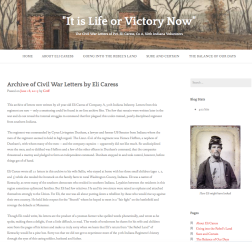 21 letters by Eli Caress of Co. A, 50th Indiana. Letters from the 50th Ind. are rare and the few that remain do not reveal the internal struggles in command that first plagued this under-trained, poorly disciplined regiment. Eli wrote to his wife and three small children while she tended the family farm in southern Indiana where loyalties between the residents sometimes splintered families. Words of tenderness ooze from Eli’s letters and make us truly sorry to learn that Eli’s return from the war would be a pine box. LINK
21 letters by Eli Caress of Co. A, 50th Indiana. Letters from the 50th Ind. are rare and the few that remain do not reveal the internal struggles in command that first plagued this under-trained, poorly disciplined regiment. Eli wrote to his wife and three small children while she tended the family farm in southern Indiana where loyalties between the residents sometimes splintered families. Words of tenderness ooze from Eli’s letters and make us truly sorry to learn that Eli’s return from the war would be a pine box. LINK
Fighting with “Birney’s Zouaves”
 These diary pages were written by George W. Shue (b. 1842), the son of John H. Shue—a hotel keeper and farmer—and Melinda Brenner. Both parents were of German ancestry and resided in Safe Harbor Manor township, Lancaster county, PA. George enlisted in Co. I, 23rd Pennsylvania (“Birney’s Zouaves”) on 1 Sept. 1861 at Philadelphia. He was wounded at Cold Harbor on 1 June 1864 and mustered out with the company on 8 Sept. 1864. At least two of his brothers served in the Civil War as well; Harrison B. Shue served in Co. 178th Penn. in 1862, and Harry B. Shue enlisted in the 168th Penn. LINK
These diary pages were written by George W. Shue (b. 1842), the son of John H. Shue—a hotel keeper and farmer—and Melinda Brenner. Both parents were of German ancestry and resided in Safe Harbor Manor township, Lancaster county, PA. George enlisted in Co. I, 23rd Pennsylvania (“Birney’s Zouaves”) on 1 Sept. 1861 at Philadelphia. He was wounded at Cold Harbor on 1 June 1864 and mustered out with the company on 8 Sept. 1864. At least two of his brothers served in the Civil War as well; Harrison B. Shue served in Co. 178th Penn. in 1862, and Harry B. Shue enlisted in the 168th Penn. LINK
Charles Hadsall Diary
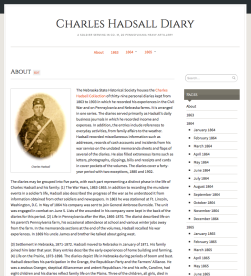 Charles Hadsall was born in 1843 in Luzerne County, Pennsylvania. During his youth he worked on the family’s small farm. In 1863, at the age of twenty, he joined the 112th Regiment, 2nd Pennsylvania Heavy Artillery, Battery M. In addition to recording the mundane events in a soldier’s life, Hadsall also described the progress of the war as he understood it from camp rumors and newspapers. In 1863 he was stationed at Ft. Lincoln, Washington, D.C. In May of 1864 the regt. joined in the Overland Campaign. Lists of the wounded in his company were kept in the back of the diaries for this period. LINK
Charles Hadsall was born in 1843 in Luzerne County, Pennsylvania. During his youth he worked on the family’s small farm. In 1863, at the age of twenty, he joined the 112th Regiment, 2nd Pennsylvania Heavy Artillery, Battery M. In addition to recording the mundane events in a soldier’s life, Hadsall also described the progress of the war as he understood it from camp rumors and newspapers. In 1863 he was stationed at Ft. Lincoln, Washington, D.C. In May of 1864 the regt. joined in the Overland Campaign. Lists of the wounded in his company were kept in the back of the diaries for this period. LINK
“The smoke of my rifle”
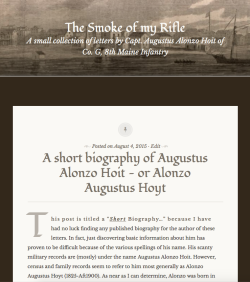 Letters by Alonzo Augustus Hoyt who was commissioned an officer in Co. G, 8th Maine Infantry on 7 September 1861. He was promoted to full Captain on 15 June 1863 when he mustered out of the 8th Maine and into Co. A, U. S. Colored Troops, 34th Infantry. He was promoted to Major on 1 March 1865. Writing to his wife, Alonzo shared his views on the progress of the war. In August 1862, he decried the lack of manpower to prosecute the war, saying “Jeff Davis is not a fool…and the sooner we put into the field a sufficient number of men to put down the rebellion, the better it will be for the North. LINK
Letters by Alonzo Augustus Hoyt who was commissioned an officer in Co. G, 8th Maine Infantry on 7 September 1861. He was promoted to full Captain on 15 June 1863 when he mustered out of the 8th Maine and into Co. A, U. S. Colored Troops, 34th Infantry. He was promoted to Major on 1 March 1865. Writing to his wife, Alonzo shared his views on the progress of the war. In August 1862, he decried the lack of manpower to prosecute the war, saying “Jeff Davis is not a fool…and the sooner we put into the field a sufficient number of men to put down the rebellion, the better it will be for the North. LINK
“Teach my hands to war”
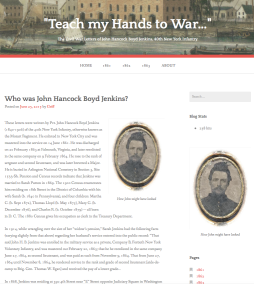 A collection of 37 letters written by Pvt. John Hancock Boyd Jenkins (1840-1906) of the 40th New York Infantry (the Mozart Regiment). He enlisted in NYC and was mustered into the service on 14 June 1861. He was discharged on 20 Feb 1863 at Falmouth, Va., and later reenlisted in the same company on 9 Feb 1864. He rose to the rank of sergeant and second lieutenant, and was later breveted a Major. Vital records reveal that Jenkins married Sarah Putton in 1869 but these letters were penned to Mary A. Benjamin—an intimate correspondent though for the year and half they wrote each other, they never met face to face. LINK
A collection of 37 letters written by Pvt. John Hancock Boyd Jenkins (1840-1906) of the 40th New York Infantry (the Mozart Regiment). He enlisted in NYC and was mustered into the service on 14 June 1861. He was discharged on 20 Feb 1863 at Falmouth, Va., and later reenlisted in the same company on 9 Feb 1864. He rose to the rank of sergeant and second lieutenant, and was later breveted a Major. Vital records reveal that Jenkins married Sarah Putton in 1869 but these letters were penned to Mary A. Benjamin—an intimate correspondent though for the year and half they wrote each other, they never met face to face. LINK
They will get but little duty out of me
 “They will get but little duty out of me,” crowed Silas Townsend of Lakeville, Plymouth County, Mass. who served in the 29th Mass and later in the 3rd Mass Cavalry. Though this service record is impressive on paper, the residue of letters surviving written to his father reveal a man in uniform devoid of patriotism, lacking in Christian character, mistrusting of his wife, and replete with cowardice. Remarkably, Silas even stooped to have his family spy on his wife when he suspected she might disobey his directions. LINK
“They will get but little duty out of me,” crowed Silas Townsend of Lakeville, Plymouth County, Mass. who served in the 29th Mass and later in the 3rd Mass Cavalry. Though this service record is impressive on paper, the residue of letters surviving written to his father reveal a man in uniform devoid of patriotism, lacking in Christian character, mistrusting of his wife, and replete with cowardice. Remarkably, Silas even stooped to have his family spy on his wife when he suspected she might disobey his directions. LINK
“Mother, don’t worry about me”
 Though brothers John and Caleb Chase would serve in two different regiments, their paths both crossed with one of the most polarizing figures in Civil War history—Nathan Bedford Forrest. Caleb enlisted in the 3rd Minn—a regiment that endured ridicule and condemnation for its surrender to Forrest in July 1862 at Murfreesboro. When John entered the service, he joined the 9th Minn that had the misfortune of facing Forrest at Brice’s Crossroads where John was wounded and taken prisoner. Both brothers died in the war. LINK
Though brothers John and Caleb Chase would serve in two different regiments, their paths both crossed with one of the most polarizing figures in Civil War history—Nathan Bedford Forrest. Caleb enlisted in the 3rd Minn—a regiment that endured ridicule and condemnation for its surrender to Forrest in July 1862 at Murfreesboro. When John entered the service, he joined the 9th Minn that had the misfortune of facing Forrest at Brice’s Crossroads where John was wounded and taken prisoner. Both brothers died in the war. LINK
Trumpet of Freedom
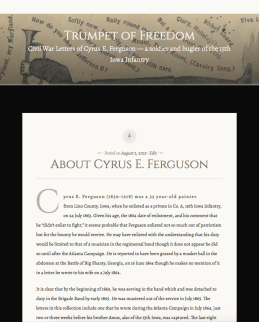 Cyrus E. Ferguson was a 33 year-old painter from Linn County, IA, when he enlisted as a private in Co. A, 15th Iowa in July 1863. Commenting that he “didn’t enlist to fight,” it seems probable that Ferguson enlisted primarily for the bounty he would receive and possibly with the understanding that his duty would be limited to that of a bugler though it does not appear he did so until after the Atlanta Campaign. He is reported to have been grazed by a musket ball in the abdomen at the Battle of Big Shanty, GA, in June 1864 though no mention of it was made in a letter to his wife on 4 July 1864. By early 1865, he was serving in the Brigade Band. He mustered out of the service in July 1865. LINK
Cyrus E. Ferguson was a 33 year-old painter from Linn County, IA, when he enlisted as a private in Co. A, 15th Iowa in July 1863. Commenting that he “didn’t enlist to fight,” it seems probable that Ferguson enlisted primarily for the bounty he would receive and possibly with the understanding that his duty would be limited to that of a bugler though it does not appear he did so until after the Atlanta Campaign. He is reported to have been grazed by a musket ball in the abdomen at the Battle of Big Shanty, GA, in June 1864 though no mention of it was made in a letter to his wife on 4 July 1864. By early 1865, he was serving in the Brigade Band. He mustered out of the service in July 1865. LINK
“This fight will tell the story”
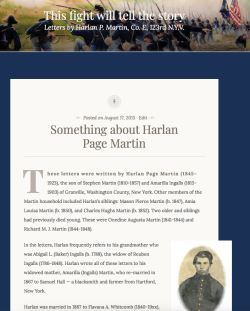 A small collection of letters by Harlan P. Martin of Co. E, 123rd New York. Harlan wrote all of these letters to his widowed mother, Amarilla (Ingalls) Martin, who re-married in 1867 to Samuel Hall — a blacksmith and farmer from Hartford, New York. Harlan’s letters are written from Tennessee, Georgia, and North Carolina. After the war, Harlan married Flavana A. Whitcomb. Before the war, Harlan was a farmer, but afterwards he moved to Truckee, CA where he was employed as a logger. In 1910 he was living in Butte, California, and employed as a lumber manufacturer. Late in life he resided in Sacramento where he died in 1923. LINK
A small collection of letters by Harlan P. Martin of Co. E, 123rd New York. Harlan wrote all of these letters to his widowed mother, Amarilla (Ingalls) Martin, who re-married in 1867 to Samuel Hall — a blacksmith and farmer from Hartford, New York. Harlan’s letters are written from Tennessee, Georgia, and North Carolina. After the war, Harlan married Flavana A. Whitcomb. Before the war, Harlan was a farmer, but afterwards he moved to Truckee, CA where he was employed as a logger. In 1910 he was living in Butte, California, and employed as a lumber manufacturer. Late in life he resided in Sacramento where he died in 1923. LINK
The Bowdoinham Letters
 These letters were sent to the John & Seraphina Brown family of Bowdoinham, Maine; mostly to their daughter, Mary Bartlett Brown. Four were from Pvt. Bainbridge P. Brown of Co. D, 3rd Maine. Five were from Sgt. Edward (“Ned”) Wiggin, Jr. of the 6th Maine Battery. Two were from Alonzo K. Chase & his brother Sanford Crosby Chase and two were from Davis Norton Abbott, who were all civilian contractors in the war department. LINK
These letters were sent to the John & Seraphina Brown family of Bowdoinham, Maine; mostly to their daughter, Mary Bartlett Brown. Four were from Pvt. Bainbridge P. Brown of Co. D, 3rd Maine. Five were from Sgt. Edward (“Ned”) Wiggin, Jr. of the 6th Maine Battery. Two were from Alonzo K. Chase & his brother Sanford Crosby Chase and two were from Davis Norton Abbott, who were all civilian contractors in the war department. LINK
Civil War Letters of Henry E. Mumford
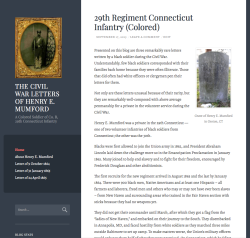 This site includes three rare letters by Henry E. Mumford, a black soldier in the 29th Connecticut — one of two volunteer infantries of black soldiers from Connecticut; the other was the 30th. Understandably, few black soldiers corresponded with their families back home because they were often illiterate. Those that did often had white officers or clergymen pen their letters for them. The letters are remarkably well-composed, with above average penmanship for a private in the volunteer service during the Civil War. LINK
This site includes three rare letters by Henry E. Mumford, a black soldier in the 29th Connecticut — one of two volunteer infantries of black soldiers from Connecticut; the other was the 30th. Understandably, few black soldiers corresponded with their families back home because they were often illiterate. Those that did often had white officers or clergymen pen their letters for them. The letters are remarkably well-composed, with above average penmanship for a private in the volunteer service during the Civil War. LINK
The Rebecca Breidenstein Collection
 These letters were part of a collection of letters and other ephemera belonging at one time to the descendants of the Shirey Family of Berks County, Pennsylvania. They are the letters addressed to Rebecca Breidenstein by both her first & second husbands during the Civil War. Rebecca’s first husband was Jacob H. Schaeffer (1836-1861) who served in Durell’s Independent Battery D. Rebecca’s second husband was Franklin H. Shirey who served in Co. K, 179th Penn, and later in Co. D, 123rd Penn. LINK
These letters were part of a collection of letters and other ephemera belonging at one time to the descendants of the Shirey Family of Berks County, Pennsylvania. They are the letters addressed to Rebecca Breidenstein by both her first & second husbands during the Civil War. Rebecca’s first husband was Jacob H. Schaeffer (1836-1861) who served in Durell’s Independent Battery D. Rebecca’s second husband was Franklin H. Shirey who served in Co. K, 179th Penn, and later in Co. D, 123rd Penn. LINK
“I stood in my tracks”
 Benjamin Franklin Hulburd’s whose advanced age did not prevent him from offering his services to fight for the Union. It was Benjamin’s misfortune to be placed in the 7th Vermont which came to be known as the “hard luck” regiment; the regiment lost half its members from disease against only 13 battle casualties. Benjamin’s letters are a delight to read & add rich insight to the service of the boys in the 7th (and 2nd) Vermont. His advanced age offers a more mature perspective on the war not normally offered by a private. LINK
Benjamin Franklin Hulburd’s whose advanced age did not prevent him from offering his services to fight for the Union. It was Benjamin’s misfortune to be placed in the 7th Vermont which came to be known as the “hard luck” regiment; the regiment lost half its members from disease against only 13 battle casualties. Benjamin’s letters are a delight to read & add rich insight to the service of the boys in the 7th (and 2nd) Vermont. His advanced age offers a more mature perspective on the war not normally offered by a private. LINK
“I long to see you again”
 Willis McDonald of Co. F, 17th Connecticut wrote these letters to his fiancee Mary Esther Cole (1839-1922) of Norwalk, Conn. Although Willis was born and raised in Brooklyn, he relocated to Norwalk in 1858 where he learned the carpenters trade and first formed his acquaintance with Mary. In “a spirit of uncontrollable patriotism, ” Willis enlisted in August 1862 and served three years with the 17th Connecticut. Sadly there is little battle content even though the regiment fought at Chancellorsville and Gettysburg. LINK
Willis McDonald of Co. F, 17th Connecticut wrote these letters to his fiancee Mary Esther Cole (1839-1922) of Norwalk, Conn. Although Willis was born and raised in Brooklyn, he relocated to Norwalk in 1858 where he learned the carpenters trade and first formed his acquaintance with Mary. In “a spirit of uncontrollable patriotism, ” Willis enlisted in August 1862 and served three years with the 17th Connecticut. Sadly there is little battle content even though the regiment fought at Chancellorsville and Gettysburg. LINK
“No Babies Play”
 Letters written by 37 year-old Joseph Hazen (1827-1874) of Hammond, St Lawrence County, NY, to his Canadian-born wife, Mary Van Schoick and their children. The 20th N.Y. Cavalry was organized in September 1863 but Joseph did not join the regiment until the following year when recruiters offered huge bounties to fill the depleted rosters. He enlisted on 1 Sept 1864 and was sent by a transport ship to the regiment in winter quarters at Camp Getty, a few miles from Norfolk, Virginia. LINK
Letters written by 37 year-old Joseph Hazen (1827-1874) of Hammond, St Lawrence County, NY, to his Canadian-born wife, Mary Van Schoick and their children. The 20th N.Y. Cavalry was organized in September 1863 but Joseph did not join the regiment until the following year when recruiters offered huge bounties to fill the depleted rosters. He enlisted on 1 Sept 1864 and was sent by a transport ship to the regiment in winter quarters at Camp Getty, a few miles from Norfolk, Virginia. LINK
Diary of Henry Knox Danner
 This Civil War diary belonged to Henry (“Harry”) Knox Danner (1837-1920) of the 30th Pennsylvania Infantry, Co. K. Danner identifies himself as the owner of the diary on its first page, along with his hometown of Emmitsburg, Frederick County, Maryland — a town divided during the war, with some men fighting for the Union, and some for the Confederacy. Indeed, Harry’s older brother, Joseph Warren Danner (1836-1901) served in Co. H, 1st North Carolina Cavalry (Confederate) during the war. LINK
This Civil War diary belonged to Henry (“Harry”) Knox Danner (1837-1920) of the 30th Pennsylvania Infantry, Co. K. Danner identifies himself as the owner of the diary on its first page, along with his hometown of Emmitsburg, Frederick County, Maryland — a town divided during the war, with some men fighting for the Union, and some for the Confederacy. Indeed, Harry’s older brother, Joseph Warren Danner (1836-1901) served in Co. H, 1st North Carolina Cavalry (Confederate) during the war. LINK
Franklin S. Twitchell // Co. B. 13th Conn
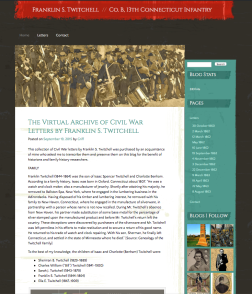 Franklin S. Twitchell enlisted as a corporal in Co. B, 13th Connecticut Infantry. They were mustered into the service between Nov 25, 1861 and 7 Jan 1862. Franklin re-enlisted as a veteran in Feb 1864 and was with his regiment in Sept 1864 when he was taken prisoner at the Battle of Winchester on 19 Sept. He is reported to have died on 9 Dec 1864 at the Confederate Prison Camp at Salisbury, N.C. By Nov 1864, Salisbury Prison “held more than 10,000 men. Twenty-eight percent of soldiers held there died in captivity. Burials before the overcrowding had been in coffins and in separate graves. LINK
Franklin S. Twitchell enlisted as a corporal in Co. B, 13th Connecticut Infantry. They were mustered into the service between Nov 25, 1861 and 7 Jan 1862. Franklin re-enlisted as a veteran in Feb 1864 and was with his regiment in Sept 1864 when he was taken prisoner at the Battle of Winchester on 19 Sept. He is reported to have died on 9 Dec 1864 at the Confederate Prison Camp at Salisbury, N.C. By Nov 1864, Salisbury Prison “held more than 10,000 men. Twenty-eight percent of soldiers held there died in captivity. Burials before the overcrowding had been in coffins and in separate graves. LINK
John L. Hebron, 2nd Ohio Infantry
 John L. Hebron was born in Steubenville, OH, in 1842. A granite & marble cutter by trade, John enlisted in Sept 1861 as a bugler in Co. G, Second Ohio. He was at the battles of Ivy Mountain, Perryville, Murfreesboro, Stone River, Hoover’s Gap, Chickamauga, Lookout Mountain, Missionary Ridge, and others. At Stone River, when the color bearer of the 13th Arkansas (Confederate) was shot, the flag was captured by Col. McCook, who gave it to bugler Hebron to take to the rear, which he did in safety. He was honorably discharged in October 1864, after 3 years without the slightest physical injury though his brother Charles died after only a few months in the 13th Ohio Cavalry. LINK
John L. Hebron was born in Steubenville, OH, in 1842. A granite & marble cutter by trade, John enlisted in Sept 1861 as a bugler in Co. G, Second Ohio. He was at the battles of Ivy Mountain, Perryville, Murfreesboro, Stone River, Hoover’s Gap, Chickamauga, Lookout Mountain, Missionary Ridge, and others. At Stone River, when the color bearer of the 13th Arkansas (Confederate) was shot, the flag was captured by Col. McCook, who gave it to bugler Hebron to take to the rear, which he did in safety. He was honorably discharged in October 1864, after 3 years without the slightest physical injury though his brother Charles died after only a few months in the 13th Ohio Cavalry. LINK
“Hunting rebels as a dog would a fox”
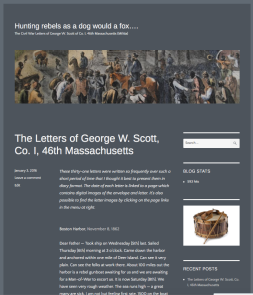 George W. Scott (1840-1884) enlisted as a musician in Co. I, 46th Mass. He was the son of Dr. William and Emeret (McIntosh) Scott of Manchester, Conn. George had at least five sisters, three who were mentioned frequently in these letters. George’s father studied medicine and graduated from the Medical Institute at Pittsfield, Massachusetts. He established himself soon after marriage (1833) in Wapping, Connecticut, but a few years later changed his residence to Manchester. These 30+ letters were written so frequently over such a short period of time that I thought it best to present them in diary format. LINK
George W. Scott (1840-1884) enlisted as a musician in Co. I, 46th Mass. He was the son of Dr. William and Emeret (McIntosh) Scott of Manchester, Conn. George had at least five sisters, three who were mentioned frequently in these letters. George’s father studied medicine and graduated from the Medical Institute at Pittsfield, Massachusetts. He established himself soon after marriage (1833) in Wapping, Connecticut, but a few years later changed his residence to Manchester. These 30+ letters were written so frequently over such a short period of time that I thought it best to present them in diary format. LINK
“Soldiering is a very uncertain game”
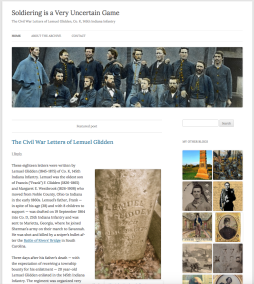 Eighteen letters by Lemuel Glidden (1845-1875) of Co. K, 145th Indiana. Lemuel’s father, Frank, was drafted at age 38 (Sept 1864) into Co. D, 25th Ind. & sent to Marietta, GA, where he was killed by a sniper’s bullet after the Battle of Rivers’ Bridge in SC. Three days after his father’s death—expecting to receive a township bounty—20 year-old Lemuel Glidden enlisted in the 145th Ind. They were mustered in Feb 1865 & sent to Nashville; then moved to Chattanooga and Dalton, Georgia. The regiment skirmished at Spring Place (Chatsworth) and at Tunnel Hill, GA; afterwards on performed railroad guard duty. LINK
Eighteen letters by Lemuel Glidden (1845-1875) of Co. K, 145th Indiana. Lemuel’s father, Frank, was drafted at age 38 (Sept 1864) into Co. D, 25th Ind. & sent to Marietta, GA, where he was killed by a sniper’s bullet after the Battle of Rivers’ Bridge in SC. Three days after his father’s death—expecting to receive a township bounty—20 year-old Lemuel Glidden enlisted in the 145th Ind. They were mustered in Feb 1865 & sent to Nashville; then moved to Chattanooga and Dalton, Georgia. The regiment skirmished at Spring Place (Chatsworth) and at Tunnel Hill, GA; afterwards on performed railroad guard duty. LINK
The Civil War Letters of William Busby
 These letters were by William Busby who emigrated to the US from England with his parents about 1840, settling in Western Mass. In 1855 (age 19) he left Mass and joined a sister and a couple of brothers in Linn County, Iowa. He enlisted in Co. H, 20th Iowa. Except for four months in winter ’62-’63, when hospitalized in Springfield, MO, William served with his regiment throughout their campaigns in MO, MS, LA, TX, and AR. William’s last known letter was written on New Year’s Day, 1865. Military records indicate he died in a New Orleans hospital on 12 Feb 1865 — a victim of chronic diarrhea. LINK
These letters were by William Busby who emigrated to the US from England with his parents about 1840, settling in Western Mass. In 1855 (age 19) he left Mass and joined a sister and a couple of brothers in Linn County, Iowa. He enlisted in Co. H, 20th Iowa. Except for four months in winter ’62-’63, when hospitalized in Springfield, MO, William served with his regiment throughout their campaigns in MO, MS, LA, TX, and AR. William’s last known letter was written on New Year’s Day, 1865. Military records indicate he died in a New Orleans hospital on 12 Feb 1865 — a victim of chronic diarrhea. LINK
“I shall be willing to suffer”
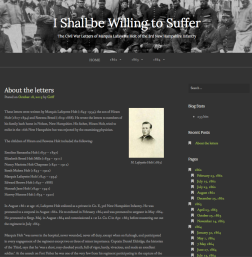 Marquis Lafayette Holt enlisted as a private in Co. E, 3rd N.H. He was promoted to a corporal in August 1862. He re-enlisted in Feb 1864 and promoted to Sergt. in May 1864. He was promoted to Sergt. Maj. in Aug 1864 and commissioned a 1st Lt. Co. C in Apr. 1865 before mustering out of the regiment in July 1865. Marquis “was never in the hospital, never wounded, never off duty—except when on furlough—and participated in every engagement of the regiment except 2 or 3 of minor importance. LINK
Marquis Lafayette Holt enlisted as a private in Co. E, 3rd N.H. He was promoted to a corporal in August 1862. He re-enlisted in Feb 1864 and promoted to Sergt. in May 1864. He was promoted to Sergt. Maj. in Aug 1864 and commissioned a 1st Lt. Co. C in Apr. 1865 before mustering out of the regiment in July 1865. Marquis “was never in the hospital, never wounded, never off duty—except when on furlough—and participated in every engagement of the regiment except 2 or 3 of minor importance. LINK
For the Union
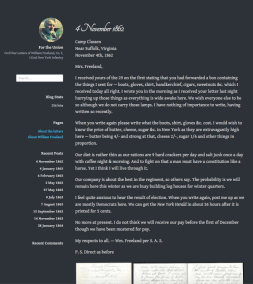 These letters were written by William Freeland (1814-1864), Co. F, 132nd New York, to his wife Mary Freeland in NYC. William was captured with several others in his regt. on 1 Feb 1864 during a skirmish at Batchelder’s Creek—8 miles west of New Bern, NC—and he died 6 weeks later from malnutrition. Official records show he died at Cahawba, AL, though a letter from the captain of Co. F informed William’s wife that it was his belief William “died at Richmond on Belle Isle whilst he was detained a prisoner there — this information I obtained through a person who was himself a prisoner there….” LINK
These letters were written by William Freeland (1814-1864), Co. F, 132nd New York, to his wife Mary Freeland in NYC. William was captured with several others in his regt. on 1 Feb 1864 during a skirmish at Batchelder’s Creek—8 miles west of New Bern, NC—and he died 6 weeks later from malnutrition. Official records show he died at Cahawba, AL, though a letter from the captain of Co. F informed William’s wife that it was his belief William “died at Richmond on Belle Isle whilst he was detained a prisoner there — this information I obtained through a person who was himself a prisoner there….” LINK
Sgt. Theodore Harman, 153rd Pennsylvania
 A collection of Civil War Letters by Theodore Harman of Wind Gap, Northampton county, Pennsylvania who died while serving as a sergeant in Co. I, 153rd Pennsylvania.
A collection of Civil War Letters by Theodore Harman of Wind Gap, Northampton county, Pennsylvania who died while serving as a sergeant in Co. I, 153rd Pennsylvania.
“I came to fight for my country and so I will stand my ground and won’t run,” he wrote prior to the Battle of Chancellorsville. Days later, after the battle, he would write his wife, “I never thought I would come safe out of that fight but God and my legs spared me.” Theodore did not survive the war. He contracted typhoid fever at Brooks Station, Virginia, in mid-June 1863 and was transferred to the Columbia College Hospital in Washington D. C. where he died on 29 June 1863. LINK
Reluctant Yanks
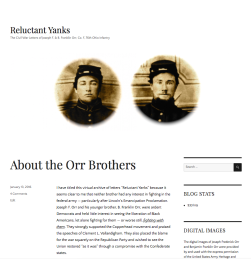 Brothers Joseph F. Orr and B. Franklin Orr were ardent Democrats and never favored the liberation of Black Americans, let alone fighting for them—or worse still, fighting with them. They supported the Copperhead movement and praised the speeches of Clement L. Vallandigham. They blame the Republican Party for the war and hoped to see the Union restored “as it was” by a negotiated peace. Both Orr brothers were drafted in Columbiana Co., OH in the fall of 1862 and compelled to serve 9 months duty in Co. F, 76th OVI. They survived the war, but both died not long after. LINK
Brothers Joseph F. Orr and B. Franklin Orr were ardent Democrats and never favored the liberation of Black Americans, let alone fighting for them—or worse still, fighting with them. They supported the Copperhead movement and praised the speeches of Clement L. Vallandigham. They blame the Republican Party for the war and hoped to see the Union restored “as it was” by a negotiated peace. Both Orr brothers were drafted in Columbiana Co., OH in the fall of 1862 and compelled to serve 9 months duty in Co. F, 76th OVI. They survived the war, but both died not long after. LINK
The Letters of James A Durrett
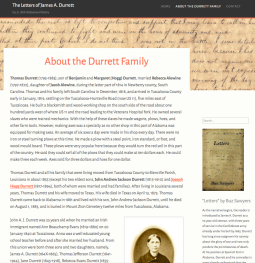 The letters of Pvt. James A. Durrett, Co. E, 18th AL. There are 7 letters by Durrett, one by his cousin Henry Durrett, and one by a friend named Nicholas Harleston Broun of Mobile. James’ father, John A. J. Durrett, at age 49, served as a private in Capt. Hassell’s Company of the 3rd AL Reserves. Incredibly, James’ mother, Ann Beauchamp (Evans) Durrett also served—as “Matron” of the 18th AL from 31 Aug to 30 Nov 1861. Presumably she cooked, washed, and “mothered” the soldiers of the 18th AL as they settled into their first winter encampment near Mobile. LINK
The letters of Pvt. James A. Durrett, Co. E, 18th AL. There are 7 letters by Durrett, one by his cousin Henry Durrett, and one by a friend named Nicholas Harleston Broun of Mobile. James’ father, John A. J. Durrett, at age 49, served as a private in Capt. Hassell’s Company of the 3rd AL Reserves. Incredibly, James’ mother, Ann Beauchamp (Evans) Durrett also served—as “Matron” of the 18th AL from 31 Aug to 30 Nov 1861. Presumably she cooked, washed, and “mothered” the soldiers of the 18th AL as they settled into their first winter encampment near Mobile. LINK
Civil War Letters of William H. H. Kinsey
 William Henry Harrison Kinsey (1841-1863) entered the service on 15 Aug 1861 at Vermont, Illinois, enlisting in Co. H, 28th Illinois for 3 years. He was born in IN & was a teacher. William’s handwriting and composition indicates he was better educated than the average Illinois volunteer, which accounts for his occupation. It appears William died on 27 July 1863 from wounds received in the 12 July assault on Jackson, MS. History books have not done justice to Kinsey’s service; a history of Fulton Co. does not even list him among their volunteers. LINK
William Henry Harrison Kinsey (1841-1863) entered the service on 15 Aug 1861 at Vermont, Illinois, enlisting in Co. H, 28th Illinois for 3 years. He was born in IN & was a teacher. William’s handwriting and composition indicates he was better educated than the average Illinois volunteer, which accounts for his occupation. It appears William died on 27 July 1863 from wounds received in the 12 July assault on Jackson, MS. History books have not done justice to Kinsey’s service; a history of Fulton Co. does not even list him among their volunteers. LINK
“This is indeed a singular war”
 Henry S. Murray was a 25 year-old tinsmith when he enlisted in the 8th New York Independent Light Artillery on 26 September 1861 for a period of three years. He was described as a 5′ 9” tinsmith with blue eyes, light hair, and a florid complexion. He mustered in on 30 October with the rank of Corporal. By the time he re-enlisted in January 1864 as a veteran, he had risen to the rank of Sergeant. The History of Delaware county claims Henry was “with the 8th New York Battery in all its engagements” though these were few in number. He mustered out with his regiment at Norfolk, Virginia, on 30 June 1865. In 1869 he married Lizzie A. Coulter who taught in a Freedman’s school in VA after the war. LINK
Henry S. Murray was a 25 year-old tinsmith when he enlisted in the 8th New York Independent Light Artillery on 26 September 1861 for a period of three years. He was described as a 5′ 9” tinsmith with blue eyes, light hair, and a florid complexion. He mustered in on 30 October with the rank of Corporal. By the time he re-enlisted in January 1864 as a veteran, he had risen to the rank of Sergeant. The History of Delaware county claims Henry was “with the 8th New York Battery in all its engagements” though these were few in number. He mustered out with his regiment at Norfolk, Virginia, on 30 June 1865. In 1869 he married Lizzie A. Coulter who taught in a Freedman’s school in VA after the war. LINK
The Civil War Letters of Hamilton Alricks, Jr.
 These letters were written by Hamilton Alricks, Jr. (1842-1889). In 1862, Hamilton served in the Pennsylvania Militia, or Reserve Corps, who were organized for the state defense. But when Lee’s army threatened to invade Pennsylvania in September 1862, they were called our by Pennsylvania Governor Curtin and mustered into service for 30 days. They were allowed to return home after the Lee’s army was turned back at Antietam, Maryland. Hamilton went on to serve the Union army as an employee in the Quartermasters’s office of the United States Department of Railroads in Tennessee. His letters are from Memphis, Nashville and Stevenson, AL. LINK
These letters were written by Hamilton Alricks, Jr. (1842-1889). In 1862, Hamilton served in the Pennsylvania Militia, or Reserve Corps, who were organized for the state defense. But when Lee’s army threatened to invade Pennsylvania in September 1862, they were called our by Pennsylvania Governor Curtin and mustered into service for 30 days. They were allowed to return home after the Lee’s army was turned back at Antietam, Maryland. Hamilton went on to serve the Union army as an employee in the Quartermasters’s office of the United States Department of Railroads in Tennessee. His letters are from Memphis, Nashville and Stevenson, AL. LINK
To the Front
 When Lincoln called for 300,000 volunteers in 1862, David Brett of North Bridgewater was 46 years old but he enlisted in the 9th Battery, Mass. Light Artillery, giving his age as 43. Brett’s health was exceptional; he lost no time on sick leave during his entire enlistment, and he visited the doctor only once, in March, 1863, to have his head bandaged after receiving an injury. At Gettysburg, Brett wrote: “I was hit by a shell in the hand but only a flesh would. It knocked me down and the wheel of the gun ran over my foot. It did not hurt so but that I am about. It is a miracle that we were not all killed. We lost 45 horses.” LINK
When Lincoln called for 300,000 volunteers in 1862, David Brett of North Bridgewater was 46 years old but he enlisted in the 9th Battery, Mass. Light Artillery, giving his age as 43. Brett’s health was exceptional; he lost no time on sick leave during his entire enlistment, and he visited the doctor only once, in March, 1863, to have his head bandaged after receiving an injury. At Gettysburg, Brett wrote: “I was hit by a shell in the hand but only a flesh would. It knocked me down and the wheel of the gun ran over my foot. It did not hurt so but that I am about. It is a miracle that we were not all killed. We lost 45 horses.” LINK
The Charles Wetmore Broadfoot Letters
 Charles W. Broadfoot was a student at UNC who interrupted his studies to enlist as a private in Co. H, 1st NC Infantry. He mustered out after 7 months service in November 1861 & later enlisted in Co. D, 43rd NC Infantry. In September 1862, he was commissioned as Aide-de-Camp to Gen. Theophilus H. Holmes, his uncle, and later entered the western theatre of the war when Holmes was made the commander of the Trans-Mississippi Department. When Holmes was sent back East to command the Reserve Forces in North Carolina, Broadfoot followed him and in May 1864 was commissioned as major of the 1st Batt., NC Reserves — most of them boys with little military training. LINK
Charles W. Broadfoot was a student at UNC who interrupted his studies to enlist as a private in Co. H, 1st NC Infantry. He mustered out after 7 months service in November 1861 & later enlisted in Co. D, 43rd NC Infantry. In September 1862, he was commissioned as Aide-de-Camp to Gen. Theophilus H. Holmes, his uncle, and later entered the western theatre of the war when Holmes was made the commander of the Trans-Mississippi Department. When Holmes was sent back East to command the Reserve Forces in North Carolina, Broadfoot followed him and in May 1864 was commissioned as major of the 1st Batt., NC Reserves — most of them boys with little military training. LINK
“These troubling times…”
 William H. Walton (1841-1864) of Kensington, NH was a “carriage apprentice” when he enlisted in Co. B, 3rd New Hampshire. He wrote all the letters (save one) to Mary Esther Blake, a shoe binder and the 20 year-old daughter of Col. John and Mary (Moulton) Blake of Kensington. These two would most likely have married each other had not the war thrust them into different worlds. For the first couple of years of separation, William’s letters indicate a deep and committed devotion to her. But as the war dragged on, the separation led to doubts and suspicions of infidelity, causing each of them to let go of the pledges they had made to each other before the war. LINK
William H. Walton (1841-1864) of Kensington, NH was a “carriage apprentice” when he enlisted in Co. B, 3rd New Hampshire. He wrote all the letters (save one) to Mary Esther Blake, a shoe binder and the 20 year-old daughter of Col. John and Mary (Moulton) Blake of Kensington. These two would most likely have married each other had not the war thrust them into different worlds. For the first couple of years of separation, William’s letters indicate a deep and committed devotion to her. But as the war dragged on, the separation led to doubts and suspicions of infidelity, causing each of them to let go of the pledges they had made to each other before the war. LINK
Civil War Letters of William Hunt Goff
 These letters were written by Cpl. William Hunt Goff (1845-1916) of Co. H, 24th Massachusetts. He enlisted at age 16 in October 1861, and was promoted to corporal in September 1864. William took part in the campaign of Burnside in North Carolina. In 1864 he re-enlisted in the same regiment, and after a visit home, rejoined the army and took part in the expedition of the James River. He was at the fall of Richmond where they kept until January 20, 1866. He was discharged in Richmond with the rank of sergeant, having participated in all of the major and minor engagements of the company. LINK
These letters were written by Cpl. William Hunt Goff (1845-1916) of Co. H, 24th Massachusetts. He enlisted at age 16 in October 1861, and was promoted to corporal in September 1864. William took part in the campaign of Burnside in North Carolina. In 1864 he re-enlisted in the same regiment, and after a visit home, rejoined the army and took part in the expedition of the James River. He was at the fall of Richmond where they kept until January 20, 1866. He was discharged in Richmond with the rank of sergeant, having participated in all of the major and minor engagements of the company. LINK
Homefront Letters to Mark Rankin
 Mark Rankin enlisted as a corporal in Co. B, 27th Mass. in Oct 1861. He was promoted to a Sgt. in Sept 1862 and to 1st Sgt in Sept 1863. He sought a commission but was unsuccessful. The 27th Mass spent the war in NC, avoiding major battles in VA, MD, and PA, but fought in smaller skirmishes & battles, including Roanoke Island, Newbern, and the Goldsboro & Gum Swamp expeditions. They faced their greatest trial at Drewry’s Bluff (May 1864). Surrounded by Confederates in a dense fog, roughly 250 men were taken prisoner including Mark who was at Andersonville until Sherman’s army invaded GA at which time Mark was moved to another prison at Millen, GA where he died in Nov. 1864. LINK
Mark Rankin enlisted as a corporal in Co. B, 27th Mass. in Oct 1861. He was promoted to a Sgt. in Sept 1862 and to 1st Sgt in Sept 1863. He sought a commission but was unsuccessful. The 27th Mass spent the war in NC, avoiding major battles in VA, MD, and PA, but fought in smaller skirmishes & battles, including Roanoke Island, Newbern, and the Goldsboro & Gum Swamp expeditions. They faced their greatest trial at Drewry’s Bluff (May 1864). Surrounded by Confederates in a dense fog, roughly 250 men were taken prisoner including Mark who was at Andersonville until Sherman’s army invaded GA at which time Mark was moved to another prison at Millen, GA where he died in Nov. 1864. LINK
Dear Nellie
 “I am now writing by the campfire. The boys are having a debate on the war & I am tired of hearing it so thought I would write. Some of them are telling what they come down here for. One says he came for his $200 [bounty] & another because he thought he should have been drafted &c. But I tell them I come because I loved my country & they laugh at me. But I want to see the rebellion put down & the stars & stripes afloat over our prosperous Republic.” Sentiments expressed by Thomas L. Bailey of Ledyard, Conn. with Co. C, 21st Conn. LINK
“I am now writing by the campfire. The boys are having a debate on the war & I am tired of hearing it so thought I would write. Some of them are telling what they come down here for. One says he came for his $200 [bounty] & another because he thought he should have been drafted &c. But I tell them I come because I loved my country & they laugh at me. But I want to see the rebellion put down & the stars & stripes afloat over our prosperous Republic.” Sentiments expressed by Thomas L. Bailey of Ledyard, Conn. with Co. C, 21st Conn. LINK
“Jeff’s prayers are as effective as Abe’s”
 George Storres Youngs enlisted in Aug 1862 as a private in Co. G, 126th New York. At the time, he was a 19 year-old carpenter living at home. Youngs was taken prisoner at the Battle of Harper’s Ferry, September 15, 1862, but was paroled on the following day as Stonewall Jackson withdrew to join Lee at Antietam. Youngs was with the 126th NY throughout the war & saw action in the prominent battles. He was promoted to corporal in Feb 1865 & mustered out June 3, 1865. LINK
George Storres Youngs enlisted in Aug 1862 as a private in Co. G, 126th New York. At the time, he was a 19 year-old carpenter living at home. Youngs was taken prisoner at the Battle of Harper’s Ferry, September 15, 1862, but was paroled on the following day as Stonewall Jackson withdrew to join Lee at Antietam. Youngs was with the 126th NY throughout the war & saw action in the prominent battles. He was promoted to corporal in Feb 1865 & mustered out June 3, 1865. LINK
The Daniels/Stone Digital Archive
 The recipient of most of these letters was Helen (“Nell”) E. Daniels (1840-Aft1924). There are a number of letters written by Alvah Hiram Daniels (1810-1864) who served in Co. H, 1st Wis. Cavalry. Alvah was as a wagoner but was not with the regiment the entire time due to periods of sickness which eventually claimed his life in 1864. There are also letters by Israel W. Stone (1839-1918) who served in Co. M, 1st IL Light Artillery. Israel was seriously wounded during the Battle of Chickamauga, had a leg amputated, and was discharged from the service early in 1865. LINK
The recipient of most of these letters was Helen (“Nell”) E. Daniels (1840-Aft1924). There are a number of letters written by Alvah Hiram Daniels (1810-1864) who served in Co. H, 1st Wis. Cavalry. Alvah was as a wagoner but was not with the regiment the entire time due to periods of sickness which eventually claimed his life in 1864. There are also letters by Israel W. Stone (1839-1918) who served in Co. M, 1st IL Light Artillery. Israel was seriously wounded during the Battle of Chickamauga, had a leg amputated, and was discharged from the service early in 1865. LINK
Diary of Thomas Wilbur Manchester
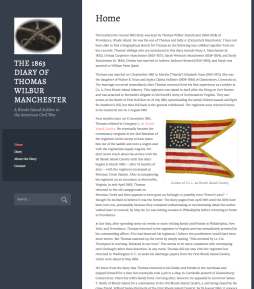 Thomas W. Manchester enlisted in Co. L, 1st R.I. Cavalry where he eventually became the commissary sergeant in the 2nd Battalion, taking him out of the saddle and onto a wagon seat of a supply wagon. The diary begins in March 1863 with the regt. encamped at Potomac Creek Station. After accompanying his regiment on an excursion to Morrisville, VA, in mid-April 1863, Thomas returned to Potomac Creek and then appears to have gone on furlough or even “French Leave.” The diary pages from April 19th until the 30th have been torn out, presumably because they contained embarrassing or incriminating detail the author wished later to conceal. An interesting read. LINK
Thomas W. Manchester enlisted in Co. L, 1st R.I. Cavalry where he eventually became the commissary sergeant in the 2nd Battalion, taking him out of the saddle and onto a wagon seat of a supply wagon. The diary begins in March 1863 with the regt. encamped at Potomac Creek Station. After accompanying his regiment on an excursion to Morrisville, VA, in mid-April 1863, Thomas returned to Potomac Creek and then appears to have gone on furlough or even “French Leave.” The diary pages from April 19th until the 30th have been torn out, presumably because they contained embarrassing or incriminating detail the author wished later to conceal. An interesting read. LINK
“An honorable peace”
 Benjamin Franklin (or Frank B.) Knause (1843-1914) was born in Waterloo, Seneca Co., New York, and was a resident of Calhoun County, Michigan, when he enlisted as a private in the “Wolverine Rifle Rangers,” or Co. E, 6th Michigan Infantry on 1 July 1861 at Fort Wayne, Michigan. He mustered into the 6th Michigan on 20 August, and re-enlisted at Port Hudson, Louisiana, on 23 February 1864, and was discharged on 15 September 1865 at Jackson, Michigan. A great many of the letters that survive were written to Frank’s older sister, Elizabeth (“Libbie”) Emma Knause (1838-1923). LINK
Benjamin Franklin (or Frank B.) Knause (1843-1914) was born in Waterloo, Seneca Co., New York, and was a resident of Calhoun County, Michigan, when he enlisted as a private in the “Wolverine Rifle Rangers,” or Co. E, 6th Michigan Infantry on 1 July 1861 at Fort Wayne, Michigan. He mustered into the 6th Michigan on 20 August, and re-enlisted at Port Hudson, Louisiana, on 23 February 1864, and was discharged on 15 September 1865 at Jackson, Michigan. A great many of the letters that survive were written to Frank’s older sister, Elizabeth (“Libbie”) Emma Knause (1838-1923). LINK
Civil War Letters of Rufus P. Staniels
 The letters of Rufus Putnam Staniels (1833-1890) to Selina Aiken Cook of Portland, Maine, whom he would later marry. Rufus enlisted in the 13th New Hampshire early in the war. He was dangerously wounded at Cold Harbor but rose to the rank of major, and became asst. adj-gen. on Gen. E. H. Ripley’s staff, whose troops were among the first to enter Richmond. While there, after the evacuation, Rufus was called upon to take down a statement by an informant who wished to warn the U.S. Government of a plot by the Secret Service of the CSA to blow up the White House and kill President Lincoln in the process. When warned, Lincoln scoffed at the threat. LINK
The letters of Rufus Putnam Staniels (1833-1890) to Selina Aiken Cook of Portland, Maine, whom he would later marry. Rufus enlisted in the 13th New Hampshire early in the war. He was dangerously wounded at Cold Harbor but rose to the rank of major, and became asst. adj-gen. on Gen. E. H. Ripley’s staff, whose troops were among the first to enter Richmond. While there, after the evacuation, Rufus was called upon to take down a statement by an informant who wished to warn the U.S. Government of a plot by the Secret Service of the CSA to blow up the White House and kill President Lincoln in the process. When warned, Lincoln scoffed at the threat. LINK
“No cause to blush”
 Most of these letters were by Albert Henry Bancroft (1840-1864) who served in Co. B, 85th NY. Albert enlisted at Bristol in Sept 1861 and served with his regiment throughout the war until he was taken prisoner at the Battle of Plymouth in North Carolina, on 20 April 1864, and imprisoned at Andersonville where he died on 11 August 1864. A few letters were written by Willie Bancroft (1844-1864) who enlisted in December 1863 as a corporal in Co. L, 24th New York State Cavalry. He was killed on 2 June 1864 in the fighting at Cold Harbor, Virginia. LINK
Most of these letters were by Albert Henry Bancroft (1840-1864) who served in Co. B, 85th NY. Albert enlisted at Bristol in Sept 1861 and served with his regiment throughout the war until he was taken prisoner at the Battle of Plymouth in North Carolina, on 20 April 1864, and imprisoned at Andersonville where he died on 11 August 1864. A few letters were written by Willie Bancroft (1844-1864) who enlisted in December 1863 as a corporal in Co. L, 24th New York State Cavalry. He was killed on 2 June 1864 in the fighting at Cold Harbor, Virginia. LINK
“Looking for a rebel to give him a pop”
 John Henry Ward (1836-1908), a “coach blacksmith” from Lebanon county, Pennsylvania, enlisted on 21 October 1861 as a sergeant in Co. K, 93rd Pennsylvania Infantry. He was wounded during the Battle at Fair Oaks on 31 May 1862 and was discharged on surgeon’s disability on 29 November 1862. There are a total of 21 letters in this virtual archive.
John Henry Ward (1836-1908), a “coach blacksmith” from Lebanon county, Pennsylvania, enlisted on 21 October 1861 as a sergeant in Co. K, 93rd Pennsylvania Infantry. He was wounded during the Battle at Fair Oaks on 31 May 1862 and was discharged on surgeon’s disability on 29 November 1862. There are a total of 21 letters in this virtual archive.
Twelve of the letters were written by Sgt. John Henry Ward to his wife, five by his brother William Gruber Ward, three by his wife Cather (Fox) Ward, and 1 by his brother Samuel Gruber Ward. LINK
